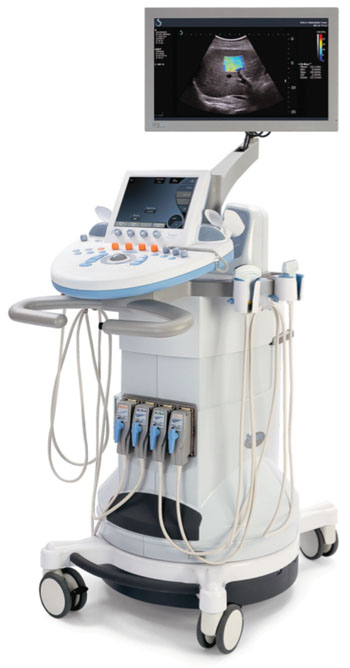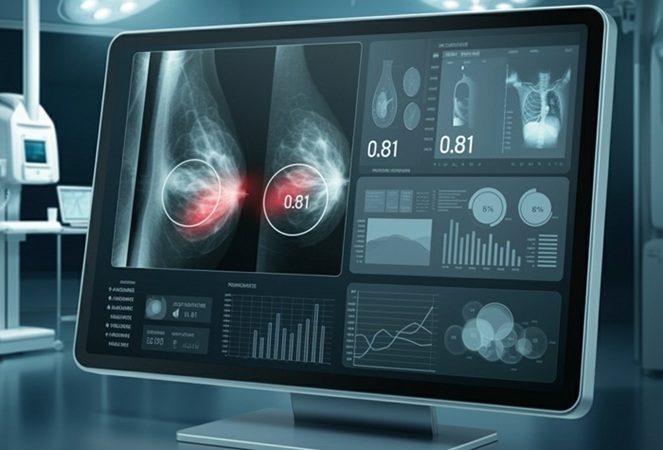SuperSonic Imagine’s Aixplorer Could Eliminate the Need for Some Liver Biopsies
|
By MedImaging International staff writers Posted on 17 Mar 2014 |

Image: The Aixplorer ultrasound with MultiWave technology (Photo courtesy of SuperSonic Imagine).

Image: Michele Debain, the global marketing director for SuperSonic Imagine (Photo courtesy of Supersonic Imagine).
SuperSonic Imagine (Aix-en-Provence, France), the French ultrasound specialist, demonstrated its Aixplorer technology to an enthusiastic audience at the European Congress of Radiology (ECR) this year.
Aixplorer has a unique ultrasound imaging technology called MultiWave Technology, which makes it the only ultrasound system that images two types of waves to better characterize tissue.
Michele Debain is Global Marketing Director for SuperSonic Imagine. She explains the nature of this technology. “This advanced technology uses two kinds of waves to image the body, one is an ultrasound wave that ensures impeccable image quality of morphology and on the other, is a shear wave (ShearWave Elastography) that measures and displays true tissue stiffness in real time. The unique ultrasound platform that supports this innovation acquires information nearly 200 times faster than conventional systems,” she emphasized.
This technology was originally designed for breast imaging but it has progressed to cover a full range of applications for the thyroid, liver, prostate, musculoskeletal and gynecology. “This expanded range has more market potential due to the fuller nature of its functionality,” said Ms. Debain. It is particularly suitable for examination of the liver. Hepatitis B, hepatitis C, and fatty liver are all increasingly prevalent worldwide and these can all lead to fibrosis and cirrhosis. Liver stiffness increases with the severity of liver fibrosis, making it an important parameter to help physicians determine the stage of disease and the kind of treatment needed. SuperSonic Imagine’s technology enables a noninvasive assessment of liver stiffness.
“When used for the liver, real time, quantitative, ShearWave Elastography has a very distinctive and unique capability,” informed Ms. Debain. “With Aixplorer’s technology we can scan the liver, measure tissue stiffness, and in some cases either avoid or confirm the need for biopsy. This expedites diagnosis.” Aixplorer could also help to monitor the impact of therapy to see if a drug treatment is actually having the desired effect.
One patient who fortunately avoided the need for a liver biopsy as a result of Aixplorer’s technology is Dan Conley, a patient who has had a fatty liver with elevated enzymes for nearly 20 years. He is a typical candidate to benefit from the technology. When his clinician suggested he have a liver biopsy to assess the state of his fatty liver condition, he in turn suggested that rather than an invasive procedure, he would rather undergo an ultrasound and ShearWave Elastography exam with Aixplorer. “There are difficulties with biopsy,” explained Mr. Conley. “A liver is a large organ so there is a high degree of heterogeneity. A biopsy in one place may not be representative of the whole liver and therefore not be a true reading of the liver’s health status.”
“I was happy to avoid a biopsy by showing my physician my measurements on the ShearWave Elastography exam. He determined that my liver was healthy and that I did not need further testing,” said a relieved Mr. Conley.
Aixplorer also has an innovative technology for vascular applications. UltraFast Doppler can give full hemodynamic, Color and Pulsed Wave Doppler results from just seconds of scanning. “The speed of this technology makes it particularly useful for children, as well as allowing for a greater efficiency of workflow and economic efficiency,” said Ms. Debain.
Related Links:
SuperSonic Imagine
Aixplorer has a unique ultrasound imaging technology called MultiWave Technology, which makes it the only ultrasound system that images two types of waves to better characterize tissue.
Michele Debain is Global Marketing Director for SuperSonic Imagine. She explains the nature of this technology. “This advanced technology uses two kinds of waves to image the body, one is an ultrasound wave that ensures impeccable image quality of morphology and on the other, is a shear wave (ShearWave Elastography) that measures and displays true tissue stiffness in real time. The unique ultrasound platform that supports this innovation acquires information nearly 200 times faster than conventional systems,” she emphasized.
This technology was originally designed for breast imaging but it has progressed to cover a full range of applications for the thyroid, liver, prostate, musculoskeletal and gynecology. “This expanded range has more market potential due to the fuller nature of its functionality,” said Ms. Debain. It is particularly suitable for examination of the liver. Hepatitis B, hepatitis C, and fatty liver are all increasingly prevalent worldwide and these can all lead to fibrosis and cirrhosis. Liver stiffness increases with the severity of liver fibrosis, making it an important parameter to help physicians determine the stage of disease and the kind of treatment needed. SuperSonic Imagine’s technology enables a noninvasive assessment of liver stiffness.
“When used for the liver, real time, quantitative, ShearWave Elastography has a very distinctive and unique capability,” informed Ms. Debain. “With Aixplorer’s technology we can scan the liver, measure tissue stiffness, and in some cases either avoid or confirm the need for biopsy. This expedites diagnosis.” Aixplorer could also help to monitor the impact of therapy to see if a drug treatment is actually having the desired effect.
One patient who fortunately avoided the need for a liver biopsy as a result of Aixplorer’s technology is Dan Conley, a patient who has had a fatty liver with elevated enzymes for nearly 20 years. He is a typical candidate to benefit from the technology. When his clinician suggested he have a liver biopsy to assess the state of his fatty liver condition, he in turn suggested that rather than an invasive procedure, he would rather undergo an ultrasound and ShearWave Elastography exam with Aixplorer. “There are difficulties with biopsy,” explained Mr. Conley. “A liver is a large organ so there is a high degree of heterogeneity. A biopsy in one place may not be representative of the whole liver and therefore not be a true reading of the liver’s health status.”
“I was happy to avoid a biopsy by showing my physician my measurements on the ShearWave Elastography exam. He determined that my liver was healthy and that I did not need further testing,” said a relieved Mr. Conley.
Aixplorer also has an innovative technology for vascular applications. UltraFast Doppler can give full hemodynamic, Color and Pulsed Wave Doppler results from just seconds of scanning. “The speed of this technology makes it particularly useful for children, as well as allowing for a greater efficiency of workflow and economic efficiency,” said Ms. Debain.
Related Links:
SuperSonic Imagine
Latest Ultrasound News
- Non-Invasive Ultrasound-Based Tool Accurately Detects Infant Meningitis
- Breakthrough Deep Learning Model Enhances Handheld 3D Medical Imaging
- Pain-Free Breast Imaging System Performs One Minute Cancer Scan
- Wireless Chronic Pain Management Device to Reduce Need for Painkillers and Surgery
- New Medical Ultrasound Imaging Technique Enables ICU Bedside Monitoring
- New Incision-Free Technique Halts Growth of Debilitating Brain Lesions
- AI-Powered Lung Ultrasound Outperforms Human Experts in Tuberculosis Diagnosis
- AI Identifies Heart Valve Disease from Common Imaging Test
- Novel Imaging Method Enables Early Diagnosis and Treatment Monitoring of Type 2 Diabetes
- Ultrasound-Based Microscopy Technique to Help Diagnose Small Vessel Diseases
- Smart Ultrasound-Activated Immune Cells Destroy Cancer Cells for Extended Periods
- Tiny Magnetic Robot Takes 3D Scans from Deep Within Body
- High Resolution Ultrasound Speeds Up Prostate Cancer Diagnosis
- World's First Wireless, Handheld, Whole-Body Ultrasound with Single PZT Transducer Makes Imaging More Accessible
- Artificial Intelligence Detects Undiagnosed Liver Disease from Echocardiograms
- Ultrasound Imaging Non-Invasively Tracks Tumor Response to Radiation and Immunotherapy
Channels
Radiography
view channel
AI Algorithm Uses Mammograms to Accurately Predict Cardiovascular Risk in Women
Cardiovascular disease remains the leading cause of death in women worldwide, responsible for about nine million deaths annually. Despite this burden, symptoms and risk factors are often under-recognized... Read more
AI Hybrid Strategy Improves Mammogram Interpretation
Breast cancer screening programs rely heavily on radiologists interpreting mammograms, a process that is time-intensive and subject to errors. While artificial intelligence (AI) models have shown strong... Read moreMRI
view channel
AI-Assisted Model Enhances MRI Heart Scans
A cardiac MRI can reveal critical information about the heart’s function and any abnormalities, but traditional scans take 30 to 90 minutes and often suffer from poor image quality due to patient movement.... Read more
AI Model Outperforms Doctors at Identifying Patients Most At-Risk of Cardiac Arrest
Hypertrophic cardiomyopathy is one of the most common inherited heart conditions and a leading cause of sudden cardiac death in young individuals and athletes. While many patients live normal lives, some... Read moreNuclear Medicine
view channel
PET Tracer Enables Same-Day Imaging of Triple-Negative Breast and Urothelial Cancers
Triple-negative breast cancer (TNBC) and urothelial bladder carcinoma (UBC) are aggressive cancers often diagnosed at advanced stages, leaving limited time for effective treatment decisions.... Read more
New Camera Sees Inside Human Body for Enhanced Scanning and Diagnosis
Nuclear medicine scans like single-photon emission computed tomography (SPECT) allow doctors to observe heart function, track blood flow, and detect hidden diseases. However, current detectors are either... Read more
Novel Bacteria-Specific PET Imaging Approach Detects Hard-To-Diagnose Lung Infections
Mycobacteroides abscessus is a rapidly growing mycobacteria that primarily affects immunocompromised patients and those with underlying lung diseases, such as cystic fibrosis or chronic obstructive pulmonary... Read moreGeneral/Advanced Imaging
view channel
New Ultrasmall, Light-Sensitive Nanoparticles Could Serve as Contrast Agents
Medical imaging technologies face ongoing challenges in capturing accurate, detailed views of internal processes, especially in conditions like cancer, where tracking disease development and treatment... Read more
AI Algorithm Accurately Predicts Pancreatic Cancer Metastasis Using Routine CT Images
In pancreatic cancer, detecting whether the disease has spread to other organs is critical for determining whether surgery is appropriate. If metastasis is present, surgery is not recommended, yet current... Read moreImaging IT
view channel
New Google Cloud Medical Imaging Suite Makes Imaging Healthcare Data More Accessible
Medical imaging is a critical tool used to diagnose patients, and there are billions of medical images scanned globally each year. Imaging data accounts for about 90% of all healthcare data1 and, until... Read more
Global AI in Medical Diagnostics Market to Be Driven by Demand for Image Recognition in Radiology
The global artificial intelligence (AI) in medical diagnostics market is expanding with early disease detection being one of its key applications and image recognition becoming a compelling consumer proposition... Read moreIndustry News
view channel
GE HealthCare and NVIDIA Collaboration to Reimagine Diagnostic Imaging
GE HealthCare (Chicago, IL, USA) has entered into a collaboration with NVIDIA (Santa Clara, CA, USA), expanding the existing relationship between the two companies to focus on pioneering innovation in... Read more
Patient-Specific 3D-Printed Phantoms Transform CT Imaging
New research has highlighted how anatomically precise, patient-specific 3D-printed phantoms are proving to be scalable, cost-effective, and efficient tools in the development of new CT scan algorithms... Read more
Siemens and Sectra Collaborate on Enhancing Radiology Workflows
Siemens Healthineers (Forchheim, Germany) and Sectra (Linköping, Sweden) have entered into a collaboration aimed at enhancing radiologists' diagnostic capabilities and, in turn, improving patient care... Read more




















